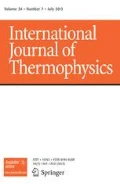Abstract
Given that the Korean government is implementing what has been termed the energy standards and labelling program for windows, window companies will be required to assign window ratings based on the experimental results of their product. Because this has added to the cost and time required for laboratory tests by window companies, the simulation system for the thermal performance of windows has been prepared to compensate for time and cost burdens. In Korea, a simulator is usually used to calculate the thermal performance of a window through WINDOW/THERM, complying with ISO 15099. For a single window, the simulation results are similar to experimental results. A double window is also calculated using the same method, but the calculation results for this type of window are unreliable. ISO 15099 should not recommend the calculation of the thermal properties of an air cavity between window sashes in a double window. This causes a difference between simulation and experimental results pertaining to the thermal performance of a double window. In this paper, the thermal properties of air cavities between window sashes in a double window are analyzed through computational fluid dynamics (CFD) simulations with the results compared to calculation results certified by ISO 15099. The surface temperature of the air cavity analyzed by CFD is compared to the experimental temperatures. These results show that an appropriate calculation method for an air cavity between window sashes in a double window should be established for reliable thermal performance results for a double window.









Similar content being viewed by others
Abbreviations
- \(\lambda _{eff} \) :
-
Effective conductivity
- \(h_{cv} \) :
-
The convective heat transfer coefficient
- \(h_{r} \) :
-
The radiative heat transfer coefficient
- d :
-
Thickness or width of the air cavity in the direction of the heat flow
- Nu :
-
Nusselt number
- T\(_\mathrm{cc}\) :
-
Thermodynamic temperature of the cold side (K)
- T\(_\mathrm{ch}\) :
-
Thermodynamic temperature of the hot side (K)
- L\(_\mathrm{h}\) :
-
Largest cavity dimensions in horizontal directions
- L\(_\mathrm{v}\) :
-
Largest cavity dimensions in vertical directions
- \(\rho _{ai} \) :
-
Density of air (kg\(\cdot \)m\(^{-3}\))
- \(L_h \) :
-
Acceleration due to gravity (m\(\cdot \)s\(^{-2}\))
- g :
-
Expansion coefficient of the fill gas
- \(\beta c_{p,ai} \) :
-
Specific heat capacity of air at a constant pressure level (J\(\,\cdot \,\)kg\(^{-1}\,\cdot \,\)K\(^{-1}\))
References
H.J. Kwak, H.I. Jang, H.S. Lee, J.Y. Eom, S.J. Suh, Korean J. Air Condit. Refrig. Eng. 25, 338–345 (2013)
K.S. Kim, G.S. Choi, J.S. Kang, Y.M. Kim, Korean J. Air Condit. Refrig. Eng. 6, 137–138 (2013). [2013 summer conference]
Ministry of Trade, Industry and Energy (MOTIE), Operational regulation on equipment for efficiency management, 2016-137 (2016)
KATS, KS F 2278: test method of thermal resistance for windows and doors (2014)
KATS, KS F 2292: the method of air tightness for windows and doors (2013)
ISO, ISO 15099:2003(E) thermal performance of windows, doors and shading devices—detailed calculations (2003)
ISO, ISO 10077-1:2006(E) thermal performance of windows, doors and shutters—calculation of thermal transmittance part 1: general (2006)
ISO, ISO 10077-2:2012(E) thermal performance of windows, doors and shutters—calculation of thermal transmittance part 2: numerical method for frames (2012)
LBNL, THERM 6.3/WINDOW 6.3 NFRC simulation manual (2013)
Y.J. Lee, E.J. Oh, S.K. Kim, G.S. Choi, J.S. Kang, Int. J. Korea Inst. Ecol. Archit. Environ. 16, 79–85 (2016)
Y.J. Lee, E.J. Oh, S.K. Kim, H.J. Choi, Y.M. Kim, Int. J. Korea Inst. Ecol. Archit. Environ. 16, 77–82 (2016)
M.J. Bae, G.S. Choi, H.J. Choi, J.S. Kang, Y.M. Kim, Appl. Mech. Mater. 865, 383–389 (2017)
K.S. Kim, G.S. Choi, J.S. Kang, Y.M. Kim, Korean J. Air Condit. Refrig. Eng. 6, 640–641 (2014). [2014 summer conference]
Acknowledgements
This work was supported by the Korea Institute of Energy Technology Evaluation and Planning (KETEP) and by the Ministry of Trade, Industry and Energy (MOTIE) of the Republic of Korea (No. 2015000000210)
Author information
Authors and Affiliations
Corresponding author
Additional information
Special Issue: Advances in Thermophysical Properties.
Rights and permissions
About this article
Cite this article
Kang, Js., Oh, EJ., Bae, MJ. et al. A Numerical Study of the Thermal Characteristics of an Air Cavity Formed by Window Sashes in a Double Window. Int J Thermophys 38, 180 (2017). https://doi.org/10.1007/s10765-017-2309-4
Received:
Accepted:
Published:
DOI: https://doi.org/10.1007/s10765-017-2309-4


